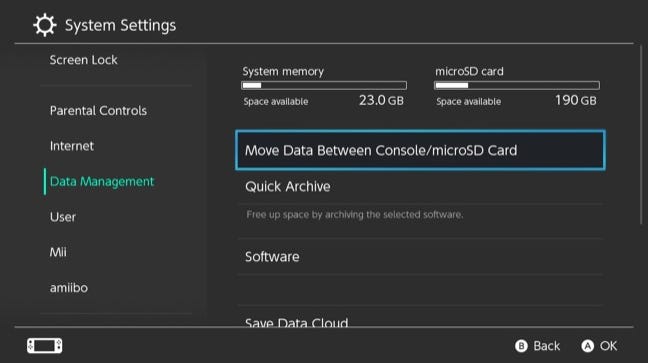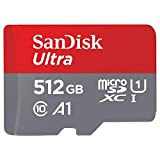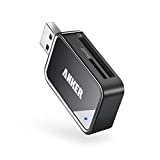
If you’ve outgrown your Nintendo Switch’s memory card and no longer have any space left to download games or save media, it’s time for an upgrade. The good news is that it’s possible to transfer your data without having to download everything again.
Expensive Memory Cards Won’t Improve Performance
If you’ve run out of storage on your Switch, it’s important to buy a big enough memory card to avoid having to repeat this process in the future. What’s not important is buying the fastest, most expensive memory card you can find.
Buy a UHS-I memory card for your Switch, like the SanDisk 512GB Ultra MicroSDXC. Nintendo specifies a minimum read speed of 60 to 95MB/sec, so don’t waste your money on expensive memory cards for use with your Switch console.
SanDisk 512GB UHS-I microSDXC
SanDisk 512GB Ultra MicroSDXC UHS-I Memory Card with Adapter – 100MB/s, C10, U1, Full HD, A1, Micro SD Card – SDSQUAR-512G-GN6MA
With maximum read speeds of 100MB/sec, this SanDisk Ultra microSDXC memory card meets Nintendo’s specification for ideal Switch read speeds.
Method 1: Use a Computer to Copy Files
This method is the fastest way to switch memory cards and should copy everything without too much back and forth. Unfortunately, it doesn’t always work as advertised. Nintendo’s instructions are deceptively simple, but Mac users in particular report countless issues.
Regardless of what we tried, we couldn’t get this method working so your mileage may vary. Windows users may have better luck since Nintendo’s instructions specifically mention this platform.
Note: You’ll need an SD card adapter (like this one) or dedicated microSD reader (like this Anker 2-in-1) for this to work. If you don’t have one, skip to method 2 below.
microSD to USB
Anker 2-in-1 USB 3.0 SD Card Reader for SDXC, SDHC, SD, MMC, RS-MMC, Micro SDXC, Micro SD, Micro SDHC Card and UHS-I Cards
Read all manner of SD and microSD cards (UHS-I only) with this handy card reader that fits into a standard USB-A slot.
The first thing you should do is download the official SD Association Memory Card Formatter for Windows or macOS. Install the app, then insert your new memory card. Make sure “Quick format” is selected, then hit the “Format” button and wait for the action to complete.

Remove the SD card from your computer and put it aside. Turn off your Switch console, then take out the old memory card and connect it to your PC. Copy the “Nintendo” folder to your local disk (we recommend putting it on the desktop or in your Downloads folder for easy access).

With the copy complete, remove your old memory card (don’t delete anything) and put it aside. Insert the new memory card that you formatted earlier, and copy the “Nintendo” folder to the root directory.

Finally, once the files have been copied, remove your new memory card and place it into your Switch. Turn the console on and wait. If everything goes to plan, you won’t see an error when you turn your console on. Head to Settings > Data Management to see whether your memory card is recognized.

If you see an error saying that the memory card is corrupted or cannot be read, you can try the process again. One Reddit commenter made some detailed suggestions you might want to try, but we had no success.
If you’re not having any joy, you can try the more long-winded but reliable second method below.
Method 2: Use the Internal Memory as a Stepping Stone
Your Switch has either 32 GB (original model and Lite) or 64 GB (OLED model) of internal memory. You can use this as a stepping stone to copy data from your old memory card to your new one. It can take some swapping of memory cards, but it works and is almost certainly quicker than downloading your games again.
The first thing you should do is move everything off your Switch onto your new memory card. To do this, turn off your console and remove the old memory card, then insert your new console and turn the Switch on. Head to Settings > System > Formatting Options > Format microSD Card. Before you proceed, make sure you have the new memory card in the console and format it.

With your memory card prepared and ready for use, head to Settings > Data Management > Move Data Between Console/microSD card and choose “Move to microSD card” from the menu.

Now copy as much data as possible from your Switch to your new memory card (assuming your new memory card is big enough, everything should fit). When you’re done, head to Settings > Data Management > Manage Screenshots and Videos > System Memory and choose “Copy All Screenshots and Videos to microSD card” first, followed by “Delete All Screenshots and Videos in System Memory” to create more free space.
Now turn your Switch off again, and swap back to your old memory card. Boot the console, head to Settings > Data Management > Move Data Between Console/microSD card then choose “System Memory” from the list. Now copy as much as you can from your old memory card to your (now empty) internal storage.
With that done, power off your Switch, insert your new memory card, and copy everything you just moved to system memory to your new microSD using the option in Settings > Data Management > Move Data Between Console/microSD card > microSD.
Repeat this process as many times as necessary until all of your data has been moved from the old memory card to the new one, using your Switch internal storage as a stepping stone. Because the Switch has copied the data, everything should work without giving you any errors about not being able to recognize the card or corrupt data.
Now Fill Up That Memory Card
Now you’ve got plenty of space, it’s time to catch up on some of the best Switch games you can buy. You can also save some money and fill up on cheap Switch games too.


